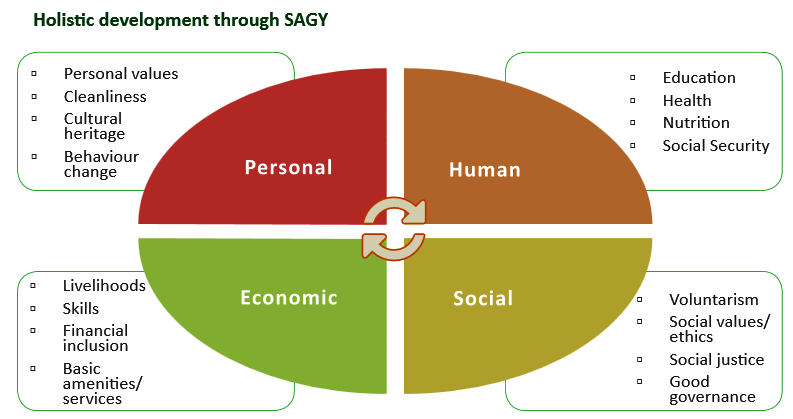Governance
Assessment of Saansad Adarsh Gram Yojana
- 22 Jun 2020
- 7 min read
Why in News
- Recently, a study by the Ministry of Rural Development has observed that the Saansad Adarsh Gram Yojana (SAGY) has not been able to achieve the desired objectives and failed to make a significant impact.
- The study was conducted as part of the Fifth Common Review Mission (CRM) for “independent assessment” of the progress of various programmes and schemes of the Rural Development Ministry.
Key Points
- Study/Assessment: The study was conducted by a team comprising retired bureaucrats, academics and research organisations etc. The team visited around 120 villages, in 21 districts across eights states
- Major Findings:
- Low selection of Panchayats: Since the launch of the scheme only 1,855 gram panchayats have been selected across five phases, with only seven in Phase 5.
- Lack of Interest and Funds: Model villages under the scheme are hit by lack of interest and funds. In many of SAGY villages, the MPs did not give any significant fund from Members of Parliament Local Area Development Scheme (MPLADS). Example:
- In Arood village of Khandwa district in Madhya Pradesh, out of 118 activities planned in 2014, only about 60 %have been achieved and the rest are pending for lack of funds.
- Lack of Political Will: The concept of SAGY has not percolated down to field officials due to lack of accountability and political will.
- Issues with Declaration: Even villages declared as Adarsh Grams in some districts were found yet to be declared Open Defecation Free.
- Limited Impact: In some cases, where MPs have been proactive, some infrastructure development has taken place, but the scheme has not made any perceptible impact.
- Low Convergence of MGNREGA with MPLAD: Lesser convergence of Mahatma Gandhi National Rural Employment Guarantee Act (MGNREGA) with MPLAD was observed in few villages.
- Rural Roads: The study expressed concern over the quality of roads constructed under schemes of state governments and maintenance of rural roads under central Pradhan Mantri Gram Sadak Yojana (PMGSY).
- Positive Impact: Progress of work was better in the Gram Panchayats where the MP has taken keen interest and allocated substantial amounts from MPLAD. Example:
- A village in Bhilwara Rajasthan was found to be very urbanised due the various development schemes taken up at the initiative of the Ex-MP.
- Reccomendations:
- Need to Enhance Impact: The report recommended that the Ministry of Rural Development may review the scheme for enhancing its impact.
- Uniform Norms: It has urged the Centre to frame a “National Rural Road Policy” to ensure uniform norms of construction and maintenance, irrespective of whether the road belongs to a state scheme or PMGSY.
- Additional Funds: The Centre should examine if the Finance Commission can provide funds for maintenance of rural roads, as many states have requested that the Centre should share the cost of maintenance.
Saansad Adarsh Gram Yojana
- SAGY is a village development project which was launched on 11th October, 2014 on the birth anniversary of Jai Prakash Narayan.
- Goal:
- Under the Yojana, Members of Parliament (MPs) are responsible for developing the socio-economic and physical infrastructure of three villages each by 2019, and a total of eight villages each by 2024.
- Objectives:
- To substantially improve the standard of living and quality of life of all sections of the population through Improved basic amenities, higher productivity and better livelihood opportunities.
- To generate models of local level development and effective local governance which can motivate and inspire neighbouring Gram Panchayats to learn and adapt.
- To nurture the identified Adarsh Grams as schools of local development to train other Gram Panchayats.
- Process:
- Gram Panchayat: The basic unit for development.
- Lok Sabha MP: Chooses a Gram Panchayat from within his/her constituency.
- Rajya Sabha MP: Chooses Gram Panchayat from the rural area of a district of his/her choice in the State from which he/she is elected.
- Nominated MPs: Choose a Gram Panchayat from the rural area of any district in the country.
- The MPs engage with the community, facilitate the Village Development Plan and mobilise the necessary resources particularly from Corporate Social Responsibility (CSR) and philanthropies.
- MPs also fill up critical gaps in the plan using the Member of Parliament Local Area Development Scheme (MPLADs) funds.
Adarsh Gram: Model Village
- A Model village is one which has adequate physical and institutional infrastructure (sustainable environment, sanitation, clean water and livelihood) in which minimum needs of all sections of the society are fully met so that they live in harmony with each other.
Way Forward
- The vision behind the evolution of SAGY villages was to create model villages by ensuring convergence and dovetailing of schemes and its proper implementation on priority basis. However, the seriousness required to achieve the motto is lacking. There is a need for MPs to be more responsible towards the scheme.
- SAGY gives focus to community participation and social mobilization of the village community can trigger a chain of other development activities in the village.
- At the same time, the Ministry of Rural Development should ensure that the SAGY villages are dealt with the vision envisaged under the scheme and are not left behind.





